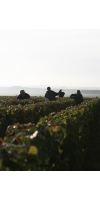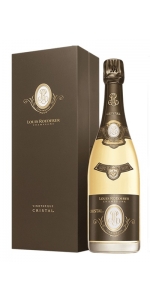Wine from Louis Roederer

ONE OF THE LAST GREAT INDEPENDENT AND FAMILY-RUN CHAMPAGNE HOUSES
When he inherited the Champagne House in 1833, the aesthete and entrepreneur Louis Roederer took a visionary approach to enriching his vines, aiming to master every stage of the wine’s creation. He forged the wine’s unique style, character, and taste. In the mid-nineteenth century, Louis Roederer acquired some of Champagne’s grand cru vineyards—an approach that contrasted sharply with contemporary practices..
While other Houses bought their grapes, Louis Roederer nurtured his vineyards, familiarized himself with the specific characteristics of each parcel, and methodically acquired the finest land. Louis Roederer’s guiding principle was that all great wine depends on the quality of the soil, a passion for tradition, and an astute vision of the future; the fame and reputation of the House of Louis Roederer was firmly established. His heir, Louis Roederer II was equally enlightened and adopted his father’s conscientious approach to the production of champagne, patrimonial estate management, and instinctive audacity.
He also drew inspiration from the many books and drawings he collected with great discernment. In the 1870s, the Louis Roederer Champagne House began to export its wines to the United States, and even to Tsar Alexander II of Russia.
A man of great taste and an inveterate researcher, Louis Roederer II fashioned an exclusive champagne for the Tsar and launched a novel concept: the very first Cuvée de Prestige. It was created in 1876 and named ‘Cristal’. Ever since, the subtleness and elegance of Cristal have forged Louis Roederer’s reputation for excellence
In the 1920s, the future heir to the House of Louis Roederer, Léon Olry-Roederer consecrated his efforts to creating a highly balanced wine—a consistent and delicate blend of several vintages, to ensure that the wine would always be of the highest quality. This wine would form the basis for the later Brut Premier. This fine blend greatly contributed to the renaissance of the House of Louis Roederer.
After his death, from 1933 onwards, the winery was managed by his strong-minded widow, Camille, who ran the Champagne House with formidable intelligence and singular dynamism. Camille loved horse racing and owned one of the most famous stables in the world; she was also an enlightened patron and embraced the more festive and pleasurable aspects of champagne. Camille Olry-Roederer held many receptions in the family’s Hôtel Particulier in Reims. These parties had a lasting impact on the history of the House and introduced a whole new generation of wine lovers to the joys of Louis Roederer Champagne.
Her grandson, Jean-Claude Rouzaud, an oenologist and agronomist, took over the running of the entire estate and decided to consolidate the vineyards. Through his passionate commitment to the metier of wine-growing, he cultivated more than ever the inventive qualities that are so representative of the House’s philosophy.
The Louis Roederer House has remained an independent, family-owned company and is now managed by Jean-Claude’s son, Frédéric Rouzaud, who represents the seventh generation of the lineage. With the same patience and unshakeable faith in its creative vocation, the House of Louis Roederer’s annual exports total three million bottles around the world.
Louis Roederer Cristal Vinotheque Edition Brut Millesime 1997 is made from Pinot noir (62%) and Chardonnay (38%).
Color
A bright and shimmering golden color, animated by an ultra-fine and swirling effervescence.
Nose
The bouquet is pure, precise and complex, mixing aromas of white flowers, almond, honey and nougat. Upon aeration, notes of red fruits and smoke are revealed, followed by warm and caramelized nuances reminiscent of macaroon, baked apples and tarte tatin.
Palate
Indulgent and velvety, the palate is rich while maintaining a great freshness thanks to a delicate effervescence. The flavors of candied Corsican citron stretch out on a finish marked by a chalky, powdery and iodized freshness, offering a dense texture and a serene length.
The property
Founded in 1776 in Reims, the Louis Roederer Champagne House has remained family-owned and independent. After more than 200 years of existence, the Louis Roederer House is still in the hands of the same family. Today led by Frédéric Rouzaud, who represents the seventh generation of the lineage, the Louis Roederer House embodies the excellence of Champagne wines around the world thanks to cuvées crafted like a work of art.
The vineyard
With nearly 241 hectares of vines, the Louis Roederer House draws its strength from its extraordinary vineyard, composed only of Grands and Premiers Crus in the Marne Valley, the Montagne de Reims and the Côte des Blancs. A true mosaic of terroirs, the Louis Roederer House's vineyard is divided into 410 plots that reflect all the diversity of the Champagne soils.
The wine
Cristal Vinothèque 1997 is made from three great vineyards known as "La Rivière", "La Montagne" and "La Côte".
The vintage
The spring of 1997, mild at first, was marked by an early bud break followed by severe frosts in April that damaged the vineyards of Verzenay and Verzy. After an early flowering in June, the rainy and cold weather until August favored the development of mildew and rot. Fortunately, the return of warm and sunny weather in August and September saved the vintage, with harvests taking place under radiant sunshine from September 15 to October 1.
Vinification and aging
Vinification is carried out in wood to the extent of 6%. Malolactic fermentation (16%). The cuvée was aged for 15 years on lees, 5 years on points and benefited from a rest of 4 years after disgorging. The dosage of this 1997 vintage champagne is 8 g/liter.
Review:
Intense nose of preserved lemons, salted yellow plums, walnuts, toast, salted caramel, roasted chestnuts and dried pineapple. Beautiful and complex, from 15 years, 5 years en pointe, before disgorgement in 2018. Delicious, salty toffee character. Soft, silky bubbles. Long and powerful. Thought-provoking. Unique. Will be launched in September 2022. Drink on release or hold.
-James Suckling 99 Points
- back
Selected Options
Wineries
Categories
Pricing
Countries
Regions
Grape Types
Wineries
Organic/Free Shipping
M. Chapoutier Hermitage Monier de la Sizeranne is made from 100 percent Shiraz.
In Hermitage, Syrah achieves its noblest expression and La Sizeranne has become a benchmark wine for the region. M. Chapoutier's roots in the Rhône date back to 1808, when the family first settled in Tain l'Hermitage. The family purchased a winery owned by Comte Monier de la Sizeranne and over time, acquired a number of excellent vineyards, including some of the oldest in France. M. Chapoutier was the first winery to put Braille on a wine label in 1996. Maurice Monier de la Sizeranne was the owner of the plot of the Hermitage, la Sizeranne until he was blinded in a hunting accident and unable to take care of the land, choosing instead to sell to the Chapoutier family. Following his accident, Maurice became the inventor of the first version of abbreviated Braille, and Chapoutier included Braille on the wine labels as a tribute to his work.
he grapes ferment in open wooden vats after total destemming. Two daily treadings ensure a good extraction of the tannins. Maturation takes place in oak casks, of which one third is new. Several rackings permit a slow and natural clarification process. The wine is unfiltered and unfined.
Review:
I was blown away by the 2019 Hermitage Monier De La Sizeranne, and if there’s a best buy out there in 2019 Hermitage, this might be it. Blackberries, black raspberries, spice box, new leather, and bouquet garni all dominate the bouquet, and it’s full-bodied, with a round, layered mouthfeel, beautiful tannins, and a rare mix of richness and elegance. It’s a stunning wine that’s guaranteed to put a smile on your face over the coming 2+ decades. Hats off to the team at Chapoutier!
-Jeb Dunnuck 97 Points
Brown Estate Chaos Theory is made from 37% Cabernet Franc 21% Cabernet Sauvignon 21% Zinfandel, 13% Merlot 8% Barbera
Dark garnet core, ruby rim. Maraschino cherry, red licorice, effervescent citrus, rose garden, chamomile blossom, Italian leather, and creme de cassis followed by cardamom, clove, cinnamon, churned cream, fresh vanilla, and a touch of graphite. Full body with juicy, creamy mouthfeel and supple tannins.
Reviews:
Mulberry, heather, and sarsaparilla are uniquely joined in this plush blend of Cabernet Franc, Cabernet Sauvignon, and Zinfandel. Notes of cardamom, cinnamon stick, chocolate-raspberry cake are dreamy. Vivid acid structure is within a frame of spiced, dried spring flowers and plum liqueur.
-Tasting Panel 93 Points
This concentrated Merlot-Zinfandel-Petite Sirah blend brings waves of cherry gastrique, raspberry liqueur, violets and caramel on the nose, while the palate leans into ripe blueberries, dark chocolate and raspberry coulis with expansive texture and velvety tannins.
-Wine Enthusiast 93 Points





